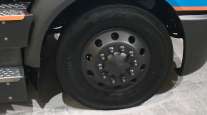Wide-Base Tire Sales Expected to Rise in 2013 Despite Challenges, Manufacturers, Fleets Say
This story appears in the Jan. 7 print edition of Transport Topics.
Despite challenges accompanying the use of wide-base tires on Class 8 trucks, experts, carriers and manufacturers said they expect to see substantial growth in their use in 2013.
“This thing is going up and up and up with no end in sight,” said Kevin Rohlwing, senior vice president of the Tire Industry Association. “Look at the different [tire makers] that are getting into the game. First there were two, and now there are six. They wouldn’t be jumping in unless there were sales to be lost.”
The reasons driving that growth are twofold: fuel economy and decreased equipment weight. Tire manufacturers said carriers can see fuel savings of up to 10% and weight savings of 700 pounds or more.
In exchange for the savings, however, carriers may have to sacrifice some retreads and pay closer attention to tire maintenance. Carriers also have to change more than just the tires because the setup requires more robust bearings and axles. Maintaining the proper air pressure also becomes more critical because fewer tires bear the load.
For Con-way Truckload, Joplin, Mo., the weight and fuel savings are worth it. “If you stick your head in the sand and don’t go to a wide-base tire, you’re giving up two-tenths of a mile per gallon, and fuel isn’t going to get any cheaper,” said Randy Cornell, vice president of maintenance for Con-way Truckload.
The carrier — a unit of Con-way Inc., Ann Arbor, Mich., which ranks No. 3 on the Transport Topics Top 100 list of the largest U.S. and Canadian for-hire carriers — began converting to wide-base tires 10 years ago. Its entire fleet of tractors uses wide-base tires, as will all trailers by the end of 2013, Cornell said.
Paul Johnston, strategic business segment manager at Michelin Americas, Greenville, S.C., said, “The demand has really taken off over the past three to four years, driven primarily by the high cost of fuel, the need for improved freight efficiencies, the anticipated impact of regulations and the concern for the environment.”
Michelin first introduced wide-base tires in 2000 and now has six versions available, Johnston said.
Tire manufacturers declined to provide sales figures, but Donn Kramer, director of product innovation for Goodyear Commercial Tire Systems, Akron, Ohio, said about 1.4% of tires sold in the United States and Canada in 2012 were wide-base singles.
“It is not a huge overall number, but the growth has been double digits, with the exception of the recession,” he said, adding that most of the growth is coming from equipment manufacturers. He said he anticipates wide-base tire sales will continue to increase as OEMs work to meet upcoming fuel-efficiency mandates.
Aaron Murphy, vice president of the China Manufacturing Alliance, Monrovia, Calif., and its Double Coin tires, supported Kramer’s growth observations, saying the sales seem to take some market share away from traditional duals, “mostly at OEM positions for linehaul or long-distance vehicles.”
Rick Phillips, director of commercial sales for Yokohama Tire Corp., Fullerton, Calif., said the use of wide-base drive tires is increasing the most. “Trailer tires were developed first, and they just caught on quicker,” he said.
And although the tires are mainly used in the trailer and drive positions, Matt Frank, truck and bus manager at Bridgestone Commercial Solutions, Nashville, Tenn., said some carriers are testing wide-base tires in the steer position.
“What they’re finding is that they’re lasting a little bit longer than the single-wide tires are lasting,” Frank said. However, he added, the tires do create some maneuverability challenges because they have a larger turning radius — which makes them best suited for waste and off-road applications.
In addition to changing their tires, carriers making the switch often have to change their mindset.
“It takes a certain mentality to say, ‘This is what we’re going to do, this is why we’re going to do it and these are the benefits I’m going to get out of it,’ ” said Bernell “Clif” Armstrong, director of commercial vehicle tire marketing, Continental Tire the Americas, Fort Mill, S.C. “It is a different animal, and you have to treat it differently.”
Because wide-base tires have different attributes, the equipment needs to be configured differently — typically with more-robust bearings.
“When you put one single tire on, you’re using an axle at a different torque angle. We had a lot of shoulder wear on our tires and realized the problem was the bearings, so we started retrofitting all of our converted tractors with the upgraded bearings,” said Chris Moore, vice president of operations for Bear Trucking Inc., San Bernardino, Calif.
“We found out the hard way that wide-base tires create a vibration and caused the brake canisters to break loose. We had to switch to special brackets to account for additional vibrations,” he said.
Bear Trucking started using wide-base tires about four years ago to reduce weight and now specs all new equipment with the tires.
“We are in the beverage industry, so every pound of a tractor-trailer is one less pound of a product we can haul,” Moore said, adding that the entire fleet will be on the tires in the next five years.
Although the bulk of the growth is coming from new vehicles, it is possible to retrofit existing equipment with wide-base tires — but that has its drawbacks.
“It is costly and time-consuming,” Goodyear’s Kramer said. For example, carriers also have to make changes to their wheels and odometer ratings.
“Wide-base tires make more revolutions per mile, so the odometer ratings change,” he explained.
NFI Industries, Cherry Hill, N.J., tried retrofitting vehicles but found it wasn’t worth it.
“When we were retrofitting, we had the narrower axles, and we had to go with 2-inch offset wheels and we didn’t see the [return on investment],” said Bill Bliem, senior vice president of fleet services for NFI, which ranks No. 24 on the for-hire TT 100.
Today, NFI specs all of its new equipment with wide-base tires. More than 80% of its 2,000-tractor fleet is on wide-base tires, as are 30% of its 7,000 trailers, Bliem said, adding that NFI made the switch to reduce weight and saves about 1,200 pounds per tractor-trailer.
Another challenge wide-base tire users face is wear. Dual tires have a contact patch area of about 22 inches, compared with 18 inches on a wide-base tire, Kramer said.
“The weight gets distributed differently on that tread face as it rotates. It is also a little shorter, so it makes more revolutions per mile. It helps aerodynamically, but it creates more opportunity for wear and wear conditions to develop,” he said.
Ideally, tires are uniform when they hit the ground, Continental’s Armstrong said. That can be more difficult to accomplish on a wide-base tire.
“Since it is twice as wide, keeping the wear pattern and the groove technology where it needs to be is a little more difficult,” he said.
Wide-base drive tires also may need to be replaced sooner.
“You have four tires instead of eight and a smaller contact patch, so the singles might get 20% to 25% fewer miles delivered versus duals,” Kramer said.
As a result, manufacturers continue to tweak tires to minimize wear.
“The primary technology used in the Michelin X One tire is Infini-Coil Technology, a quarter-mile of steel cable that allows the tire to keep its shape, ensuring a consistent footprint,” Johnston said.
Armstrong told TT, “Every manufacturer that builds wide-base has their own way of trying to keep that tread pattern on the ground, and it starts with tread design and groove technology.”
On the trailer side, wide-base tires receive the same or more miles than the duals, Bear Trucking’s Moore said.
“We bought new trailers almost three years ago. Other than repairing flats, we have the original trailer tires on, and they’ll last another year,” he said.
To maximize tire life, TIA’s Rohlwing said, carriers that move to wide-base tires should have an above-average maintenance program.
NFI Industries implemented a total vehicle alignment program when it switched to wide-base tires.
“All of our equipment at [periodic maintenance] time or once a year gets a complete total 10-wheel alignment,” Bliem said, adding that the alignment helps with wear.
Air pressure also is critical for wide-base tires. Improper inflation is going to have a faster effect on tire life and wear on wide-base tires than it would on standard duals, Rohlwing explained. It also gives them the best fuel mileage and the best casings.
To help minimize concerns over air pressure, NFI uses Meritor Tire Inflation Systems by P.S.I. and checks the gauge pressure at every preventive maintenance.
Con-way is also testing tire-inflation and tire-pressure monitoring systems.
“If you blow a tire on a dual, you can coast a while or go a little ways down the highway and not damage a wheel because you’ve got another tire holding that axle up. A driver knows that if he blows a wide-base tire, he’s going to be shut down,” Cornell said.
Goodyear’s wide-base tires have DuraSeal, a built-in tire sealant, which minimizes carrier concerns, Kramer said.
“By having DuraSeal,” he said, “Goodyear has avoided one of the biggest objections to run-ning singles.”
Carrier concerns over the availability of wide-base tires on the road also are diminishing. More service facilities have wide-base tires available, Bridgestone’s Frank said, and Cornell said Con-way used to stage tires along its routes, but that is no longer necessary.
Johnston said carriers also have reduced inventory, require fewer mounts and have easier tire-pressure maintenance because they’re not checking the inside dual tire.
Frank told TT that a less obvious benefit to wide-base tires is a smoother ride for drivers. “The center of gravity is lower with wide-base because they’re spread out more,” he said.
But despite the reported advantages, Yokohama’s Phillips said that fleets should analyze the cost per mile of their current tires and the factors driving that cost.
“Then, they need to do a serious analysis to see if they will benefit by switching to wide-base products,” he said.




